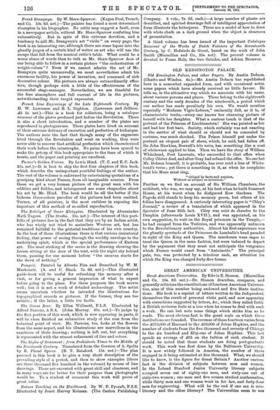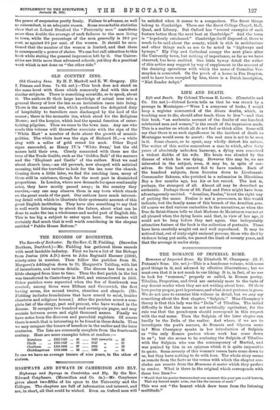GREAT AMERICAN UNIVERSITIES.
Great American Universities. By Edwin E. Slosson. (Macmillan and Co. 10s. 6d. net.)—Dr. Slosson describes, compares, and generally criticises the constitutions of fourteen American Universi- ties, nine of this number being endowed and five State institu- tions. His book is a reprint of letters written to the Independent, themselves the result of personal visits paid, and now appearing with corrections suggested by letters, Ste., which they called forth A British reviewer feels at a loss when he comes to deal with such a work. He can but note some things which strike him as he reads. The most obvious fact is the great scale on which these institutions are founded. The revenue of these fourteen varies from the £570,000 of Harvard to the .263,000 of Johns Hopkins, and the number of students from the five thousand and seventy of Chicago to the six hundred and fifty-one of Johns Hopkins. This last spends an average of £65 on the tuition of each student. It should be noted that these students are doing post-graduate work. This work was first done by the Baltimore University. It is now widely followed in America, the number of those engaged in it being estimated at five thousand. What, we should like to know, is the figure for Great Britain ? Another curious fact is the division of subjects between men and women. In the Leland Stanford Junior University literary subjects occupied seven out of eighty-one men, and sixty-one out of sixty-two women ; one man and five women studied mathematics, while thirty men and one woman went in for law, and forty-four men for engineering. What will be the end if one sex is non- literary and the other literary? The Universities seem to use
the power of suspension pretty freely. Failure to advance, as well as misconduct, is an adequate reason. Some remarkable statistics show that at Leland Stanford the "Fraternity men" contribute more than double the average of such failures to the men living in town, while the percentage of the men generally is 18.3 per cant. as against 2-5 per cent. of the women. It should be men- tioned that the number of the women is limited, and that there is consequently a power of choice. We can but call attention to this book while stating the general impression left by it. Our Univer- sities are little more than advanced schools, yet they do a practical work which is not done on "the other side."























































 Previous page
Previous page